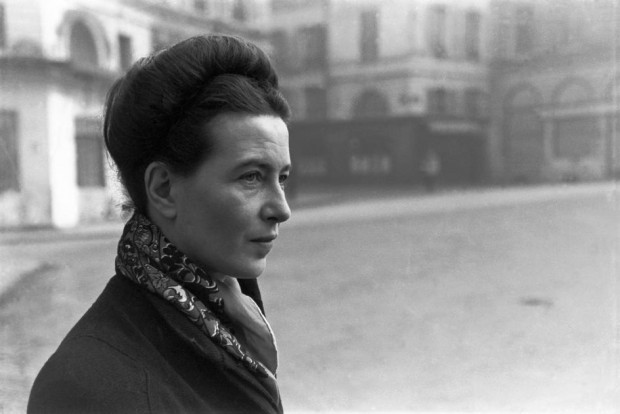An iconographic and text archive related to communication, technology and art.
January 29, 1947 ― Again I slept late. But there’s something in the New York air that makes sleep useless; perhaps it’s because your heart beats more quickly here than elsewhere―people with heart conditions sleep less, and many New Yorkers die of heart problems. In any case, I’m enjoying this windfall: the days seem too short.
Breakfast in the corner drugstore is a celebration. Orange juice, toast, café au lait―an unadulterated pleasure. Sitting on my revolving stool, I participate in a moment of American life. My solitude does not separate me from my neighbors, who are also eating alone. Rather, it’s the pleasure I feel that isolates me from them. They are simply eating; they’re not on vacation.
☛ America Day by Day by Simone de Beauvoir, tr. by Carol Cosman, Berkeley: University of California Press, [1954]1999, p. 18.
L’Amérique au jour le jour was first published in French in 1948. In it, French intellectual Simone de Beauvoir tells the story of the four months trip she took to the United-States at the beginning of the year 1947. Here’s an excerpt from the foreword by Douglas Brinkley included in the English edition:
Beauvoir’s story begins with her “smooth flight” from Paris to Newfoundland to New York’s La Guardia Airport. Embraced upon arrival by the Condé Nast set at a gaggle of cocktail parties, cheered on at Vassar College, where she took part in a symposium called “Women’s Role in Contemporary Society,” gossiped about as the “prettiest existentialist” by Janet Flanner in the New Yorker’s “Talk of the Town,” Beauvoir made a significant splash. The New York Times Magazine even commissioned an article from her―“An Existentialist Looks at Americans”―which appeared on May 25, 1947. Although much of her itinerary revolved around her well-arranged lecture schedule, she allowed plenty of free days for aimless explorations and journalistic pulse taking. Beauvoir, like an anxious literary traveler, wanted to pinpoint the intellectual fountainhead of the nation that produced the likes of Ernest Hemingway, F. Scott Fitzgerald, and John Dos Passos. The first chapters of America Day by Day take place in prosperous postwar Manhattan, where Beauvoir was overwhelmed by the cult of American consumerism, disturbed by our national attraction to luxury cars and Madison Avenue come-ons, and angered at the anticommunist groupthink mentality she encountered wherever she went. She perfectly captures the alienated sensation of being a stranger in Gotham: “Between these houses that have existed without me for years, for centuries, these streets were traveled by thousand of people who were not me, who are not me. But now I am walking here. I go down Broadway; it’s really me. I’m walking in streets not yet traveled by me, streets where my life has not yet been carved, streets without any scent of the past. No one here is concerned with my presence; I’m still a ghost, and I slip through the city without disturbing anything. And yet from now on my life will embrace the contour of these streets, these houses; New York will belong to me; I will belong to it.”(pp. xii-xiii)
I’ve tracked down the small text by Janet Flanner mentionned in Brinkley’s foreword: it was published in The New Yorker on February 22, 1947. Here’s an excerpt:
Last week, we had a talk wityh Simone de Beauvoir, the French novelist, playwright, and No. 2 Existentialist, just before she left town on a coast-to-coast lecture tour. Aware that Mlle. de Beauvoir is regarded in Paris as the female intellectual counterpart of Jean-Paul Sartre, we were all set for a grim half hour. Well, surprise! Mlle. de B. is the prettiest Existentialist you ever saw; also eager, gentle, modest, and as pleased as a Midwesterner with the two weeks she spent in New York. Her English is rickety, se we sought to draw her out in our rickety French. “I’ve walked all around Manhattan and Brooklyn,” she told us. “I flew here on a Saturday. I left my hotel, the Lincoln, the next morning at nine o’clock and walked downtown to the Battery, through an abandoned city with empty canyons. Even the drugstores and cafeterias were closed. Paris never seems so empty on Sundays. Since then, I’ve walked three or four hours every morning the weather has been nice. I’ve walked all over Washington Heights, Greenwich Village, and East Rivers. I think I like Washington Square best. I’ve also admired the city from roofs, since you can’t really see it from the streets. I’ve been to the Blue Angel, Café Society Downtown, and Sammy’s Bowery Follies, which is wonderful. It’s absolutely dissolute [crapuleux]―all those old singers, whom nobody wants, with feathers on their heads. I’ve gone to the cinema, to see your ‘thrillings,’ and I’ve been amused by the children skiing in Central Park. We haven’t enough snow in Paris for this, as a rule, or enough slopes when we do.” (The New Yorker: “The Talk of the Town” by Janet Flanner and Stanley Edgar Hyman, February 22, 1947, p. 19; full access may require a subscription)
Below is a portrait of Simone de Beauvoir photographed by Henri Cartier-Bresson in 1945 (retrieved from Magnum Photos):

- By Philippe Theophanidis
- on
- ― Published in Art, Communication, Literature
- Tagged: America, city, existentialism, New York, Simone de Beauvoir, sleep, travel, woman
